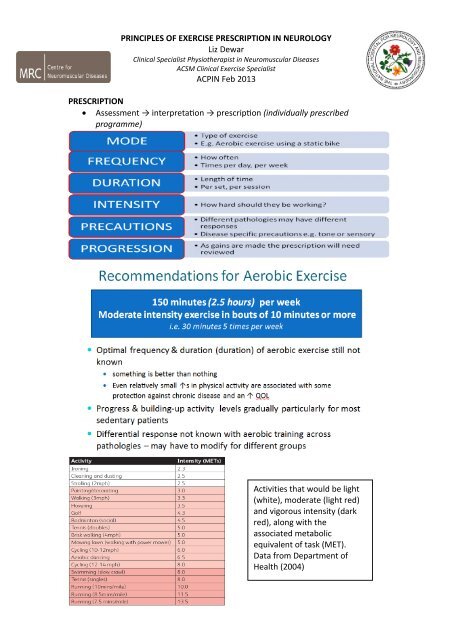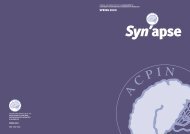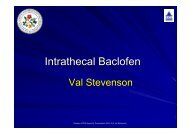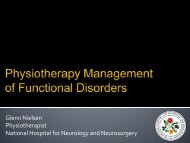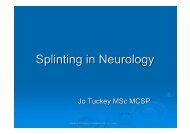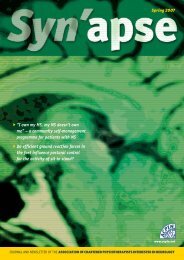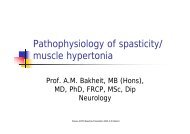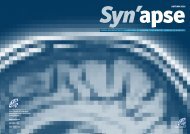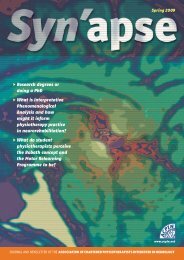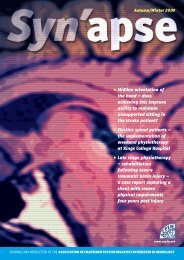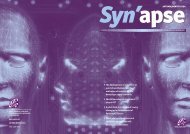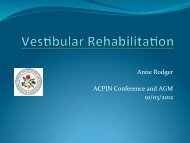Download PDF - acpin
Download PDF - acpin
Download PDF - acpin
Create successful ePaper yourself
Turn your PDF publications into a flip-book with our unique Google optimized e-Paper software.
PRINCIPLES OF EXERCISE PRESCRIPTION IN NEUROLOGY<br />
Liz Dewar<br />
Clinical Specialist Physiotherapist in Neuromuscular Diseases<br />
ACSM Clinical Exercise Specialist<br />
ACPIN Feb 2013<br />
PRESCRIPTION<br />
Assessment ї ŝŶƚĞƌƉƌĞƚĂƟŽŶї ƉƌĞƐĐƌŝƉƟŽŶ(individually prescribed<br />
programme)<br />
Activities that would be light<br />
(white), moderate (light red)<br />
and vigorous intensity (dark<br />
red), along with the<br />
associated metabolic<br />
equivalent of task (MET).<br />
Data from Department of<br />
Health (2004)
GENERAL ADVICE FOR PATIENTS<br />
• Individually prescribed aerobic and strengthening exercises are safe<br />
(following assessment & risk screening)<br />
• Feel comfortably out of breath, but still be able to talk, and the exercise<br />
should make them perspire<br />
• Do not exercise to exhaustion<br />
• Recognise when it is time to stop<br />
• Next day tiredness and fatigue<br />
• May not have enough energy left for essential functional tasks<br />
• Do it in short bouts & build up gradually<br />
• Avoid excessive eccentric activity<br />
• Be aware of ‘over-work weakness’<br />
• Muscle soreness should not last longer than 48 hours<br />
• The gym isn’t the only place to exercise<br />
• If they experience unusual symptoms or experience pain then advised to stop<br />
exercising & to seek physiotherapist or GP advice<br />
• To achieve regular physical activity, people need to integrate physical activity<br />
into their everyday lives<br />
• Make it fun & sociable!<br />
TAKE HOME MESSAGES<br />
• Physical activity is important for improving long term health and well being<br />
• Physical inactivity is highly prevalent in pw disabilities<br />
• The optimal dosage & content of exercise interventions for people with a<br />
range of long-term neurological conditions has not been clearly established
REFERENCES<br />
• American College of Sports Medicine. ACSM's Guidelines for Exercise Testing<br />
and Prescription. Philadelphia: Lippincot, Williams & Wilkins; 2006<br />
• Borg GV. Psychophysical basis of perceived exertion. Medicine and Science in<br />
Sports and Exercise 1970; 14:377-381<br />
• Brazzelli et al (2011) Physical fitness training for stroke patient. Cochrane<br />
Database of Systematic Reviews, Issue 11<br />
• Goodwin et al (2008) The effectiveness of exercise interventions for people<br />
with Parkinsons Disease: a systematic review and meta-analysis. Movement<br />
Disorders Vol. 23, No. 5, pp. 631–640<br />
• Elsworth et al (2011) Supported community exercise in people with long-term<br />
neurological conditions: a phase II randomized controlled trial. Clin Rehabil<br />
2011 25: 588<br />
• Hallal et al (2012) Global physical activity levels: surveillance<br />
progress,pitfalls,and prospects. Lancet Physical Activity Series<br />
• Health Canada (1998) Canada’s physical activity guide to health active living<br />
http://www.hc-sc.gc.ca/hppb/paguide/pdf/guideEng.pdf (PAR-Q)<br />
• Lee et al (2012) Effect of physical inactivity on major non-communicable<br />
diseases worldwide: an analysis burden of disease and life expectancy. Lancet<br />
Physical Activity Series<br />
• Pollard A, Ramdharry G, Moore S, Hallsworth K, Marsden J,Reilly M.<br />
Comparing activity levels between people with Charcot-Marie-Tooth disease<br />
and healthy controls: a pilot study. Journal of the Peripheral Nervous System<br />
2010; 15 (Supplement) p30<br />
• Reitberg et al (2004) Exercise therapy for multiple sclerosis Cochrane<br />
Database of Systematic Reviews, Issue 3<br />
• Sallis R (2009) Exercise is medicine and physicians need to prescribe it! Br J<br />
Sports Med; 43:3–4<br />
• Stroud NM, Minahan C L (2009) The impact of regular physical activity on<br />
fatigue, depression and quality of life in persons with multiple sclerosis<br />
Health and Quality of Life Outcomes, 7:68<br />
• Van Remoortal et al (2012) Validity of activity monitors in health and chronic<br />
disease : a systemic review, International Journal of Behavioural Nutrition &<br />
Physical Activity, 9:84<br />
• Voet NBM, Van der Kooi EL, Rophagen II, Lindeman E, Van Engelen BGM,<br />
Geurts ACH. Strength training and aerobic training for muscle disease<br />
(review). Cochrane Database of Systematic Reviews 2010, issue 1.<br />
• White CM, Pritchard J, Turner-Stokes L. Exercise for people with peripheral<br />
neuropathy (review). Cochrane Database of Systematic Reviews 2009, issue<br />
1.


